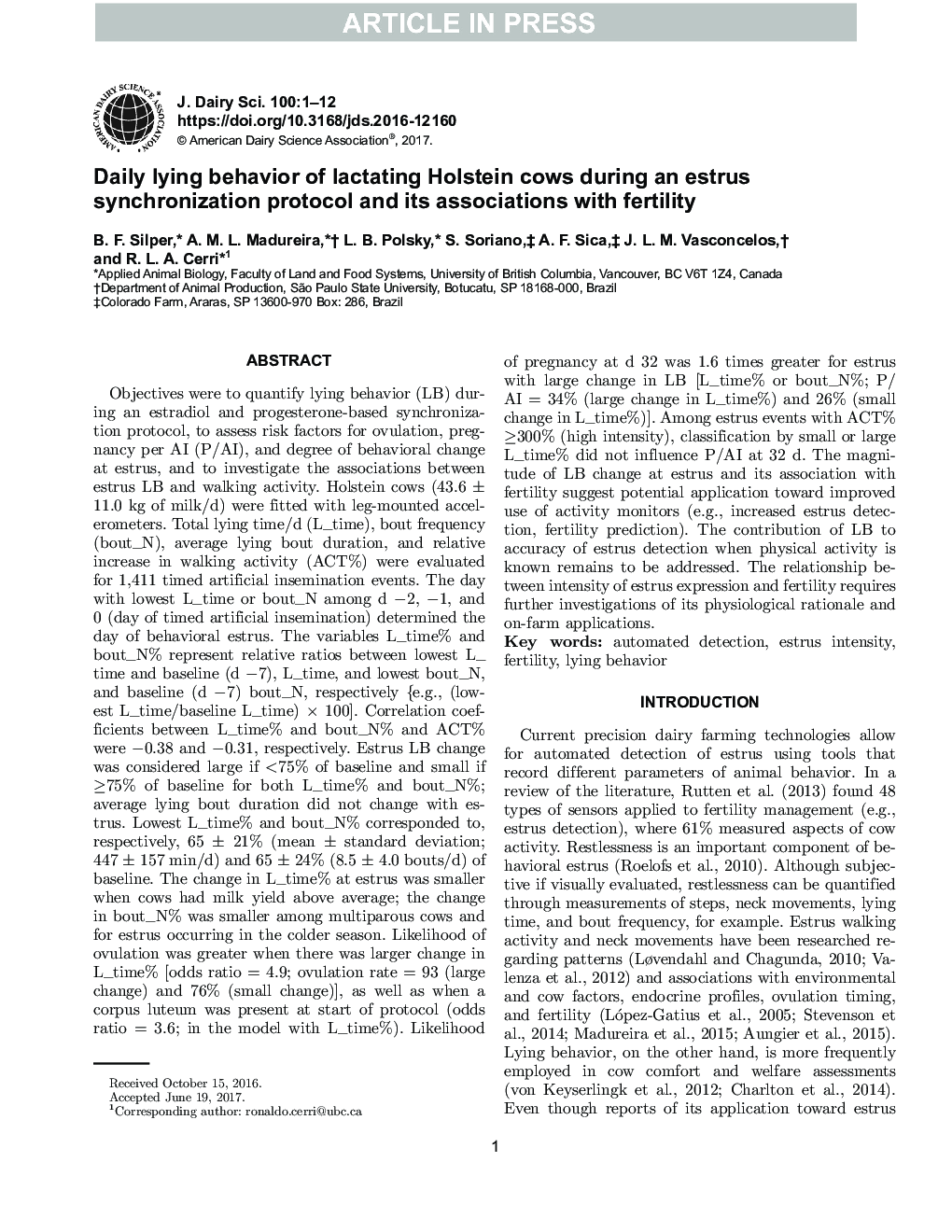| کد مقاله | کد نشریه | سال انتشار | مقاله انگلیسی | نسخه تمام متن |
|---|---|---|---|---|
| 5542035 | 1402513 | 2017 | 12 صفحه PDF | دانلود رایگان |
عنوان انگلیسی مقاله ISI
Daily lying behavior of lactating Holstein cows during an estrus synchronization protocol and its associations with fertility
ترجمه فارسی عنوان
رفتار دروغین روزانه شیر گاوهای هلشتاین در طول یک پروتکل هماهنگ سازی پروتئین و ارتباط آن با باروری
دانلود مقاله + سفارش ترجمه
دانلود مقاله ISI انگلیسی
رایگان برای ایرانیان
کلمات کلیدی
تشخیص اتوماتیک، شدت تنش باروری، رفتار دروغین،
موضوعات مرتبط
علوم زیستی و بیوفناوری
علوم کشاورزی و بیولوژیک
علوم دامی و جانورشناسی
چکیده انگلیسی
Objectives were to quantify lying behavior (LB) during an estradiol and progesterone-based synchronization protocol, to assess risk factors for ovulation, pregnancy per AI (P/AI), and degree of behavioral change at estrus, and to investigate the associations between estrus LB and walking activity. Holstein cows (43.6 ± 11.0 kg of milk/d) were fitted with leg-mounted accelerometers. Total lying time/d (L_time), bout frequency (bout_N), average lying bout duration, and relative increase in walking activity (ACT%) were evaluated for 1,411 timed artificial insemination events. The day with lowest L_time or bout_N among d â2, â1, and 0 (day of timed artificial insemination) determined the day of behavioral estrus. The variables L_time% and bout_N% represent relative ratios between lowest L_time and baseline (d â7), L_time, and lowest bout_N, and baseline (d â7) bout_N, respectively [e.g., (lowest L_time/baseline L_time) à 100]. Correlation coefficients between L_time% and bout_N% and ACT% were â0.38 and â0.31, respectively. Estrus LB change was considered large if <75% of baseline and small if â¥75% of baseline for both L_time% and bout_N%; average lying bout duration did not change with estrus. Lowest L_time% and bout_N% corresponded to, respectively, 65 ± 21% (mean ± standard deviation; 447 ± 157 min/d) and 65 ± 24% (8.5 ± 4.0 bouts/d) of baseline. The change in L_time% at estrus was smaller when cows had milk yield above average; the change in bout_N% was smaller among multiparous cows and for estrus occurring in the colder season. Likelihood of ovulation was greater when there was larger change in L_time% [odds ratio = 4.9; ovulation rate = 93 (large change) and 76% (small change)], as well as when a corpus luteum was present at start of protocol (odds ratio = 3.6; in the model with L_time%). Likelihood of pregnancy at d 32 was 1.6 times greater for estrus with large change in LB [L_time% or bout_N%; P/AI = 34% (large change in L_time%) and 26% (small change in L_time%)]. Among estrus events with ACT% â¥300% (high intensity), classification by small or large L_time% did not influence P/AI at 32 d. The magnitude of LB change at estrus and its association with fertility suggest potential application toward improved use of activity monitors (e.g., increased estrus detection, fertility prediction). The contribution of LB to accuracy of estrus detection when physical activity is known remains to be addressed. The relationship between intensity of estrus expression and fertility requires further investigations of its physiological rationale and on-farm applications.
ناشر
Database: Elsevier - ScienceDirect (ساینس دایرکت)
Journal: Journal of Dairy Science - Volume 100, Issue 10, October 2017, Pages 8484-8495
Journal: Journal of Dairy Science - Volume 100, Issue 10, October 2017, Pages 8484-8495
نویسندگان
B.F. Silper, A.M.L. Madureira, L.B. Polsky, S. Soriano, A.F. Sica, J.L.M. Vasconcelos, R.L.A. Cerri,
